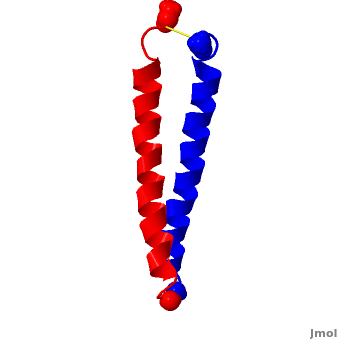C-Myc
From Proteopedia
| (8 intermediate revisions not shown.) | |||
| Line 9: | Line 9: | ||
The '''c-Myc''' [http://en.wikipedia.org/wiki/Oncogene oncogene] encodes a [http://en.wikipedia.org/wiki/Transcription_factor transcription factor], c-Myc protein, which is involved in the regulation of the [http://en.wikipedia.org/wiki/Cell_cycle cell cycle]. C-Myc belongs to the [http://en.wikipedia.org/wiki/C-myc Myc] family of proteins including B-Myc, L-Myc, N-Myc, and s-Myc. c-Myc is a [http://en.wikipedia.org/wiki/Basic_helix-loop-helix_leucine_zipper_transcription_factors b-HLH-LZ] (basic helix-loop-helix-leucine zipper) protein that must form a [http://en.wikipedia.org/wiki/Heterodimer heterodimer] with another b-HLH-LZ protein, [http://en.wikipedia.org/wiki/MAX_(gene) Max], in order to bind DNA and activate [http://en.wikipedia.org/wiki/Transcription_(genetics) transcription]. | The '''c-Myc''' [http://en.wikipedia.org/wiki/Oncogene oncogene] encodes a [http://en.wikipedia.org/wiki/Transcription_factor transcription factor], c-Myc protein, which is involved in the regulation of the [http://en.wikipedia.org/wiki/Cell_cycle cell cycle]. C-Myc belongs to the [http://en.wikipedia.org/wiki/C-myc Myc] family of proteins including B-Myc, L-Myc, N-Myc, and s-Myc. c-Myc is a [http://en.wikipedia.org/wiki/Basic_helix-loop-helix_leucine_zipper_transcription_factors b-HLH-LZ] (basic helix-loop-helix-leucine zipper) protein that must form a [http://en.wikipedia.org/wiki/Heterodimer heterodimer] with another b-HLH-LZ protein, [http://en.wikipedia.org/wiki/MAX_(gene) Max], in order to bind DNA and activate [http://en.wikipedia.org/wiki/Transcription_(genetics) transcription]. | ||
Mutations in myc proteins or overexpression of their encoding genes have been linked to several forms of cancer, among these are lymphoma, myeloma, liver, lung, and breast cancer. See<br /> | Mutations in myc proteins or overexpression of their encoding genes have been linked to several forms of cancer, among these are lymphoma, myeloma, liver, lung, and breast cancer. See<br /> | ||
| + | [[Kwon sandbox]]<br /> | ||
[[Transcription and RNA Processing]]<br /> | [[Transcription and RNA Processing]]<br /> | ||
[[Proteins involved in cancer]]<br /> | [[Proteins involved in cancer]]<br /> | ||
[[Oncogenes & Tumor Suppressor Genes]]. | [[Oncogenes & Tumor Suppressor Genes]]. | ||
| + | [[Category:Topic Page]] | ||
| Line 44: | Line 46: | ||
[[2a93]] – Cmyc-Max leucine zipper – synthetic – NMR<br /> | [[2a93]] – Cmyc-Max leucine zipper – synthetic – NMR<br /> | ||
[[2ap2]] – sCmyc + antibody<br /> | [[2ap2]] – sCmyc + antibody<br /> | ||
| - | [[1nkp]] – hCmyc + hMax + DNA | + | [[5i4z]] - hCmyc bHLHZ domain residues 348-439 - human<br /> |
| + | [[7c36]] - hCmyc residues 62-223 - NMR<br /> | ||
| + | [[5i50]] - hCmyc bHLHZ domain + DNA<br /> | ||
| + | [[6g6j]], [[6g6k]], [[6g6l]] – hCmyc + hMax<br /> | ||
| + | [[1nkp]] – hCmyc + hMax + DNA <br /> | ||
[[1mv0]] – hCmyc residues 55-68 + box-dependent-interacting protein residues 513-593 - NMR | [[1mv0]] – hCmyc residues 55-68 + box-dependent-interacting protein residues 513-593 - NMR | ||
| + | [[8ots]], [[8ott]] - hCmyc bHLHZ domain 368-420 complx with nucleosome – Cryo EM | ||
==Additional Resources== | ==Additional Resources== | ||
Current revision
| |||||||||||
3D structures of C-myc
Updated on 02-February-2025
2a93 – Cmyc-Max leucine zipper – synthetic – NMR
2ap2 – sCmyc + antibody
5i4z - hCmyc bHLHZ domain residues 348-439 - human
7c36 - hCmyc residues 62-223 - NMR
5i50 - hCmyc bHLHZ domain + DNA
6g6j, 6g6k, 6g6l – hCmyc + hMax
1nkp – hCmyc + hMax + DNA
1mv0 – hCmyc residues 55-68 + box-dependent-interacting protein residues 513-593 - NMR
8ots, 8ott - hCmyc bHLHZ domain 368-420 complx with nucleosome – Cryo EM
Additional Resources
For additional information, see: Cancer
For additional information, see: Oncogenes
For additional information, see: Transcription and RNA Processing
References
Dang, C.V.(1999) c-Myc Target Genes Involved in Cell Growth, Apoptosis, and Metabolism. Molecular and Cellular Biology, 19: 1-11.
Nair & Burley (2003) X-Ray Structures of Myc-Max and Mad-Max Recognizing DNA: Molecular Bases of Regulation by Proto-Oncogenic Transcription Factors. Cell, 112:193-205.
Ohtsuki, Nishitani, Hatamochi, Yawata, & Namba (1991) Analysis of methylation in the c-Myc gene in five human myeloma cell lines. British Journal of Haematology. 77: 172-179.
Takahashi et al., (2007) Induction of Pluripotent Stem Cells from Adult Human Fibroblasts by Defined Factors. Cell. 131: 1-12.
Kaji, Norrby, Paca, Mileikovsky, Mohseni, & Woltjen (2009) Virus-free induction of pluripotency and subsequent excision of reprogramming factors. Nature. 458: 771-776.
Gardner, Lee, & Dang (2002) The c-Myc Oncogenic Transcription Factor. [1]
Dose et al., (2006) C-Myc mediates pre-TCR-induced proliferation but not developmental progression. Blood. 108: 2669-2677.
Gilbert, S.F. http://8e.devbio.com/article.php?ch=5&id=42. September 21,2009.
C-myc gene found to play role in immune system. The Medical News. [2]
Davis AC, Wims M, Spotts GD, Hann SR, Bradley A. A null c-myc mutation causes lethality before 10.5 days of gestation in homozygotes and reduced fertility in heterozygous female mice. Genes & Development 1993 Apr;7(4):671-82
Proteopedia Page Contributors and Editors (what is this?)
Michal Harel, Hillary Sigale, Kim Smith, David Canner, Joel L. Sussman, Alexander Berchansky

